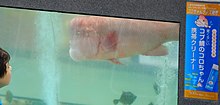Asian sheepshead wrasse
| Asian sheepshead wrasse | |
|---|---|

| |
| Scientific classification | |
| Domain: | Eukaryota |
| Kingdom: | Animalia |
| Phylum: | Chordata |
| Class: | Actinopterygii |
| Order: | Labriformes |
| Family: | Labridae |
| Genus: | Semicossyphus Günther, 1861 |
| Species: | S. reticulatus
|
| Binomial name | |
| Semicossyphus reticulatus (Valenciennes, 1839)
| |
| Synonyms | |
| |
The Asian sheepshead wrasse, Semicossyphus reticulatus, is a species of wrasse, one of the largest, native to the western Pacific Ocean, where it is only known from Korean Peninsula, China, Japan, and the Ogasawara Islands, where it inhabits rocky reef areas.[2][1] It can reach 100 cm (39 in) in total length and the greatest weight recorded for this species is 14.7 kg (32 lb).[2] This species is valued as a food fish in its native range.[1]

The Asian sheepshead wrasse, also known as kobudai in Japan, is a hermaphroditic species, meaning that it has both male and female organs which allows it to change genders. The species gained media attention when the transformation was caught on camera by the BBC Earth crew while filming in the waters near Sado Island, Japan. In 2017, it was shown on the Blue Planet II episode "One Ocean".[3]
According to Atlas Obscura, Japanese diver Hiroyuki Arakawa has had a 25-year relationship with a sheepshead wrasse in Japan’s Tateyama Bay, where he is the caretaker for an underwater Shinto shrine. He calls the fish, named "Yoriko", by hitting a bell on the underwater shrine.[4]
References
- ^ a b c Cornish, A. (Grouper & Wrasse Specialist Group) 2004. Semicossyphus reticulatus. In: IUCN 2013. IUCN Red List of Threatened Species. Version 2013.1. <www.iucnredlist.org Archived June 27, 2014, at the Wayback Machine>. Downloaded on 16 November 2013.
- ^ a b Froese, Rainer; Pauly, Daniel (eds.). "Semicossyphus reticulatus". FishBase. October 2013 version.
- ^ Cormier, Zoe (November 29, 2017). "Fish are the sex-switching masters of the animal kingdom". BBC Earth.
- ^ http://www.atlasobscura.com/articles/japanese-diver-fish-friendship-kiss

